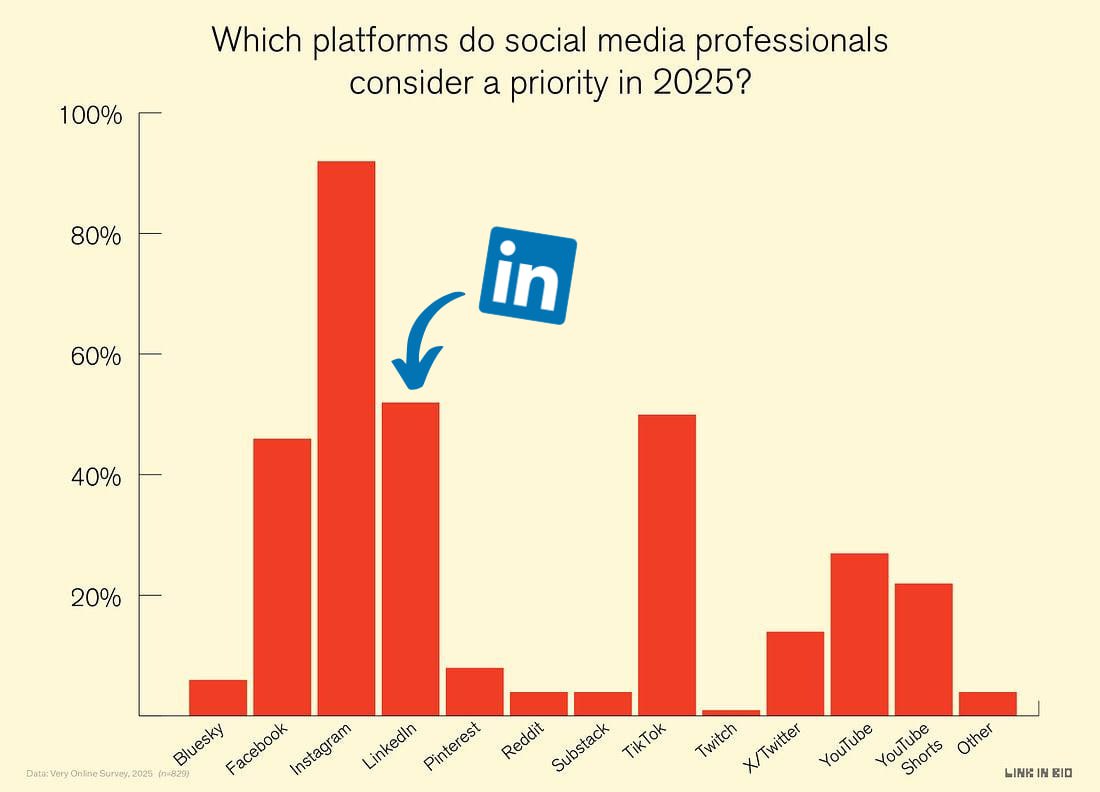A few years ago, the idea of LinkedIn being a go-to platform for social media marketers (SMMs) might have sounded like a joke.
 Fast forward to 2025, and the professional networking site has solidified its place as a powerhouse in the social media landscape. According to a recent survey by MilkKarten, LinkedIn now ranks as the second-most prioritized platform for Western SMMs, just behind Instagram, outpacing competitors like TikTok and Facebook by a significant margin.
Fast forward to 2025, and the professional networking site has solidified its place as a powerhouse in the social media landscape. According to a recent survey by MilkKarten, LinkedIn now ranks as the second-most prioritized platform for Western SMMs, just behind Instagram, outpacing competitors like TikTok and Facebook by a significant margin.
The full results of the survey are available in MilkKarten’s Link in Bio newsletter. So, what does this shift mean for brands, marketers, and the broader digital ecosystem?
LinkedIn’s Rise: From Niche to Mainstream
 The MilkKarten survey, conducted in early May 2025, asked SMMs a pivotal question: “If your brand could post on only one platform, which would it be?” Instagram took the top spot, reflecting its enduring appeal for visually-driven content and broad audience reach.
The MilkKarten survey, conducted in early May 2025, asked SMMs a pivotal question: “If your brand could post on only one platform, which would it be?” Instagram took the top spot, reflecting its enduring appeal for visually-driven content and broad audience reach.
But LinkedIn’s second-place finish — well ahead of TikTok, Facebook, and others — signals a dramatic change in how marketers view the platform. Even more striking, when asked about overall platform prioritization, LinkedIn again secured the second spot, trailing Instagram but widening its lead over other platforms.
This shift isn’t entirely unexpected. LinkedIn has evolved from a resume-hosting site into a dynamic hub for thought leadership, professional networking, and B2B marketing. By 2025, its algorithm has become more content-friendly, prioritizing engaging posts like polls, long-form articles, and video content over traditional job updates.
Brands have taken notice, using LinkedIn to build authentic relationships with decision-makers, showcase company culture, and drive lead generation. Unlike the entertainment-first focus of TikTok or the ad-saturated environment of Facebook, LinkedIn offers a space where professional value and credibility reign supreme.
What This Means for the Marketing Ecosystem
LinkedIn’s rise has far-reaching implications for brands and marketers, setting off a chain reaction across the industry.
 Here’s how the dominoes are falling:
Here’s how the dominoes are falling:
- Increased Marketing Budgets: As LinkedIn becomes a priority, brands are allocating larger portions of their budgets to the platform. This means more investment in high-quality content tailored for a professional audience—think whitepapers, case studies, and executive insights.
- Content Boom: With more budgets comes a surge in content production. Brands are posting more frequently, experimenting with formats like LinkedIn Live and carousel posts to stand out in an increasingly crowded feed.
- Demand for Tools: The influx of content is driving demand for specialized tools to streamline posting and analytics. Platforms like Hootsuite and Sprout Social are rolling out LinkedIn-specific features, while new startups are emerging to help brands track engagement metrics and optimize their strategies.
- A Crowded Feed: More content means more competition. LinkedIn’s feed is becoming a battleground, with brands vying for visibility among a growing number of posts. This “tolchoknya” (Russian for “jostling”) in the feed makes it harder for organic content to break through, pushing brands toward paid advertising options like LinkedIn’s Sponsored Content.
- Rise of Creators and Rates: As competition heats up, the demand for skilled creators — those who can craft compelling LinkedIn content — has skyrocketed. From copywriters to video producers, creators are seeing their rates climb as brands seek to differentiate themselves with authentic, high-value content.
Why LinkedIn? The Perfect Storm
 Several factors have converged to make LinkedIn a darling of SMMs. First, its audience is highly targeted—executives, decision-makers, and professionals who wield purchasing power in B2B and high-ticket B2C markets. Second, LinkedIn’s organic reach remains stronger than that of Instagram or Facebook, where algorithms heavily favor paid posts.
Several factors have converged to make LinkedIn a darling of SMMs. First, its audience is highly targeted—executives, decision-makers, and professionals who wield purchasing power in B2B and high-ticket B2C markets. Second, LinkedIn’s organic reach remains stronger than that of Instagram or Facebook, where algorithms heavily favor paid posts.
Third, the platform’s focus on professional authenticity resonates in an era where consumers crave transparency and value-driven content over flashy ads. Finally, LinkedIn’s recent push into creator tools, like its Creator Mode and newsletter feature, has made it easier for brands and individuals to build engaged communities.
For SMMs, LinkedIn offers a unique blend of scale and specificity. While Instagram excels at broad consumer engagement, LinkedIn delivers precision targeting for niche audiences, making it a must-have in any serious marketer’s toolkit.
The survey’s findings reflect this reality: LinkedIn isn’t just a secondary platform — it’s a strategic cornerstone for brands aiming to connect with professionals in a meaningful way.
Also read:
- Crafting Professional-Grade Films with LTX Studio: The AI That Replaces an Entire Studio Crew
- Capture Your Free Space Selfie: A Cosmic Opportunity with Mark Rober’s Satellite
- Instagram Embraces 3:4 Photo Format: A Win for Smartphone Photography
Looking Ahead: A Creator-Driven Future
 The ripple effects of LinkedIn’s ascent are already reshaping the marketing landscape. As budgets grow and competition intensifies, brands will need to double down on quality and creativity to cut through the noise.
The ripple effects of LinkedIn’s ascent are already reshaping the marketing landscape. As budgets grow and competition intensifies, brands will need to double down on quality and creativity to cut through the noise.
This, in turn, will fuel the creator economy, with LinkedIn influencers and content specialists becoming increasingly valuable. For marketers, the challenge will be balancing organic and paid strategies while leveraging analytics tools to stay ahead of the curve.
What seemed like a punchline a few years ago is now a reality: LinkedIn has become a cornerstone of social media marketing, second only to Instagram. As MilkKarten’s survey shows, this shift is driving investment, innovation, and opportunity — but also competition.
For brands and creators alike, the message is clear: adapt to LinkedIn’s rise, or risk being left behind in the evolving world of SMM.
Word count: ~350
This article highlights LinkedIn’s surprising rise among Western SMMs, analyzes the survey results, and explores the cascading effects on marketing budgets, content creation, and the creator economy, while including the MilkKarten survey link.






